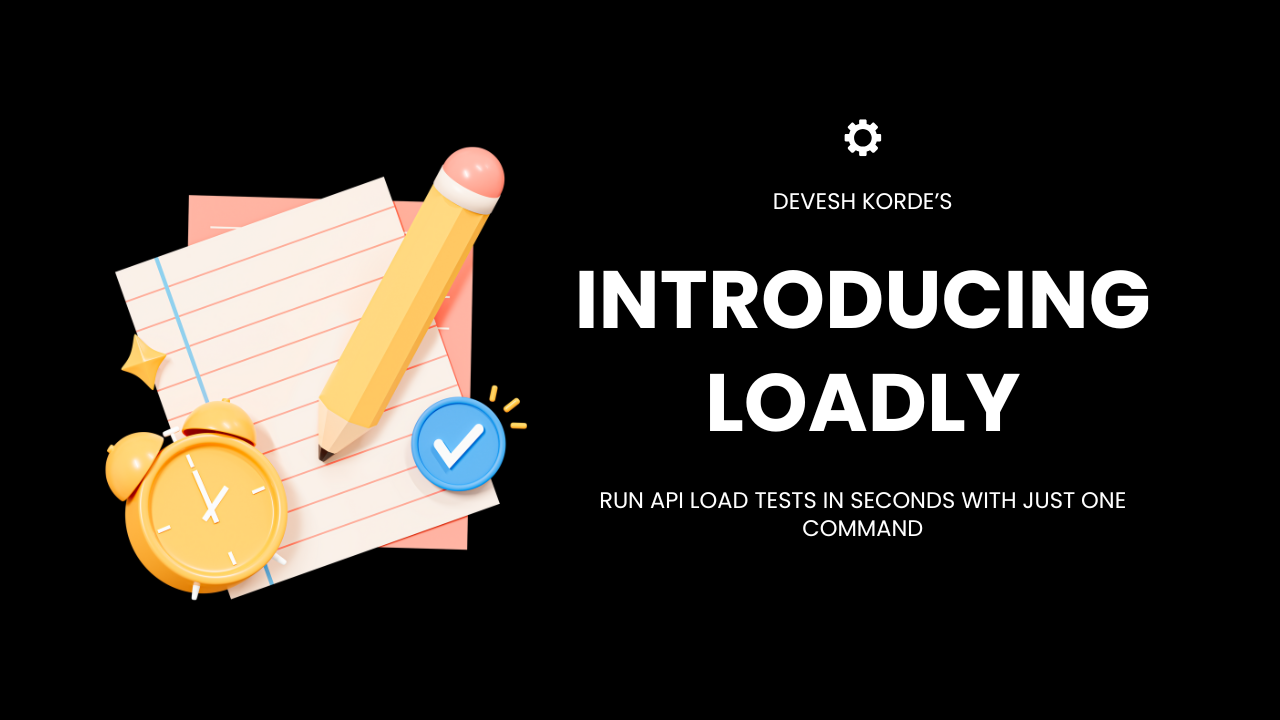Loadly ⚡
Modern, lightweight API load testing with a local React UI. Install globally, run a single command, configure endpoints in the browser, and watch live analytics stream in.
- Install: npm i -g loadly (or npm i -g @sudoDevesh/loadly if using a scoped name)
- Run: loadly run
- UI: http://localhost:3000 (auto-opens)
- Requires: Node.js 18+
📽️ Demo Video
Why Loadly?
Most load-testing tools force a choice:
- Powerful but config-heavy scripts and CLIs
- Or pretty UIs that are slow to set up and hard to automate
Loadly blends both:
- Single command startup
- Zero config to get going
- Intuitive UI for defining scenarios
- Real-time metrics without cloud accounts or agents
- 100% local: data never leaves the machine
Think “Postman + k6, but simpler, prettier, and developer-friendly.” Define endpoints and headers like in Postman; hit Run and get live charts and percentiles like k6—without a learning curve.
What You Get
- One command to launch: loadly run
- Local web UI for configuration and dashboards
- Multiple endpoints per test with weights and JSON bodies
- Simple templating: {{uuid}}, {{timestamp}}, {{randint:min,max}}
- Live metrics: RPS, success/failure, p95 latency, memory usage, status code breakdown
- Final JSON summary for copy/paste or export
- Runs entirely on the local machine (no external services)
Target Audience
- Solo devs / indie hackers who want quick API load tests
- Startups / small teams who don’t want to set up JMeter/k6
- Open-source developers who value a simple, pretty, developer-first tool
Quick Start
Install (Node 18+)
npm i -g loadly
Run
loadly run
Configure in UI
Concurrency: number of virtual users (e.g., 20)
- Duration: seconds to run (e.g., 30)
- Headers (JSON): e.g., { "Content-Type": "application/json" }
Endpoints (JSON array), example: [ { "url": "https://httpbin.org/get", "method": "GET", "weight": 2 }, { "url": "https://httpbin.org/post", "method": "POST", "body": { "id": "{{uuid}}", "ts": "{{timestamp}}" } } ]
Click “Start Testing” and watch live metrics. A final summary appears when complete.
Tip: Test a local API at http://localhost:4000 and mix fast, slow, flaky, and 404 endpoints to exercise the dashboard.
How Loadly Calculates “How Many Requests?”
Loadly is time-bound, not count-bound:
- Concurrency sets parallel workers
- Duration sets how long they run
- Throughput emerges from endpoint latency, failures, and network conditions
Total requests ≈ throughput (RPS) × duration. Increase concurrency for more pressure; increase duration for steadier percentile estimates.
Feature Highlights
- Multiple endpoints with weights
JSON bodies + templating:
- {{uuid}} — random UUID per request
- {{timestamp}} — epoch ms at send time
- {{randint:a,b}} — integer within [a, b]
Live dashboard:
- Total, Success, Failures
- RPS (requests per second)
- Avg and p95 latency (ms)
- Memory (RSS/Heap)
- Status code distribution
Abort on UI close (tests stop when the tab/socket closes)
- Final JSON summary for logs or export
Architecture Overview
- CLI: launches a local server and opens the browser
- Backend: Express + WebSocket for control and telemetry
- Engine: Node-based HTTP runner with templating and weighted endpoint selection
- Frontend: React app served statically; connects via WebSocket for live updates
Everything is self-contained and local—no databases or external services.
Developer Ergonomics
- One-command start, zero boilerplate
- JSON-based configuration with live feedback
- Clear error messages on invalid input
- Works with any HTTP API—REST, JSON-RPC, GraphQL over HTTP, internal services
- Port override: set PORT=8080 loadly run
Install and Run
Global install:
- npm i -g loadly
Launch:
- loadly run
Custom port:
- PORT=8080 loadly run
Health check:
- http://localhost:3000/health → { "ok": true }
Requires Node.js 18+.
Troubleshooting
“Cannot GET /”
- Build artifacts missing: ensure the UI is being served from ui/dist. If developing from source, rebuild the UI.
WebSocket not updating
- Ensure the CLI is running and the UI is opened from the same host/port (localhost:3000). If using a separate UI dev server, point WS to the backend port or open the built UI.
fetch is not defined
- Requires Node 18+ (engine uses global fetch).
Contributing
- Fork the repo and clone locally
- Install root and UI dependencies, then build the UI
Start in dev:
- npm run dev
UI live dev:
- cd ui && npm run dev (Vite @ 5173)
Please open issues for bugs, feature requests, or ideas. PRs welcome.
License
MIT
Philosophy
- Minimal setup, maximal feedback
- Local-first by default (privacy-friendly)
- Human-friendly UI with developer-focused power
- Designed to scale with the developer’s needs—from a smoke test to iterative performance tuning
Loadly replaces “spin up a toolchain” friction with a simple flow: run a command, paste endpoints, click Run, and learn fast.
